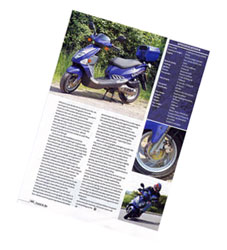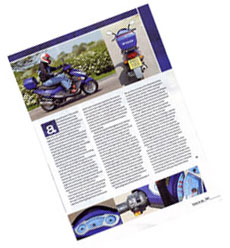TWIST & GO magazine reviews the:
PGO T-Rex 125
Read their review below:
The recent change of UK importer, along with sizeable price reduction across the entire PGP range, gave us the ideal opportunity to get a leg over the four-stroke T-Rex 125 Sportster. For me, the name T-Rex conjures up images of wobbly voices, bubble haircuts and a low slung, white Fender Stratocaster, but in this instance it is a royal blue scooter of oriental origin. With its obvious 70s rock and extinct dinosaur connotations the T-Rex name is a strange one to use for a bike but, what the heck, it might as well be called ‘Eric the scoot’, it wouldn’t really matter in the larger scheme of things.
Approaching the T-Rex outside the collection point, I was immediately struck by the squat stance of this machine; it certainly doesn’t look like a 125cc bike with its proportions more akin to a slightly chunky 50 than an eighth of a litre machine. This extends to the feel of the bike when it is first moved, the centre stand is ideally placed, making the getting on and off process a real easy thing to do, and creating the impression of a lightweight and well balanced scoot. The test bike arrived fitted with colour matched top box available as an optional extra and this also provided a useful back rest built into the moulding should any two-up riding be planned.
Turning the key is simple enough, but watch out for the kill switch being in the off position, as nothing will happen until this is returned to the positive stop. Of course a handy warning light is situated right in the centre of the dash shouting aloud to the dumb rider about the kill switches plight, but until the brain is programmed in, the red bulb means absolutely nothing to you as the engine sits there silent and motionless!
Once this is sorted, the start button actually has some impact upon the engine and it quickly leaps into life. Upon start-up the sub bass thumping of the engine initially catches one unawares – especially if the ring ding of a two-stroke power plant is your usual scoot experience. But that low down voice is also responsible for the superb drive from way down in the rev range and is worth the ear bashing. As four-strokes go, this one is not overly powerful, nor, with just a 65mph top speed, excessively fast, but the PGO does handle very well and the mass that the largish engine creates keeps the bike very stable on the bumpiest of roads or sweeping bends.
Despite being one of the lightest of all 125 four-stroke machines and pretty sharp away from a standstill, the T-Rex is a steady mover from the all important 15-20 mile an hour range upward, meaning that, like with so many other larger scoots, traffic can start to play catch up when pulling away from lights before disappearing into the mirrors again once well on the move. This may be attributable to a bad choice of roller weights etc, but more than likely, the engine is sadly lacking in the horse power department with mere nine and a half gee-gee’s at your beck and call once you get to the heady heights of 7500rpm. If the clutch could be liberated sufficiently to enable it to get there a little earlier then acceleration would be brisker no doubt. Of course a little more power would not go amiss either. If say 12bhp was attainable from the otherwise stonking little engine, the T-Rex would be transformed into a significantly more sprightly performer.
With a large dose of front brake to haul the T-Rex up, there is always a risk of the brakes being overly powerful. But with this PGO, stopping is a hassle-free affair, with the 190mm disc and floating twin piston calliper assembly providing no more braking power than is necessary. Certainly not stoppie territory, but impressive performance none-the-less. Add the rear into the equation and the 110kg machine stops on the proverbial sixpence – albeit without the usually expected impact upon the chassis. This is attributable to a very low centre of gravity with all major components slung way down in the bilges, with the result being the T-Rex stays dead straight and true throughout the process, as indeed it does during cornering with the chunky 12 in Maxxis rubber grabbing a firm hold of the tarmac during all but the stupidest of manoeuvres! Even with the centre stand dragging heavily at full tilt, the tyres kept a dutiful and watchful eye on the events and never let go once despite my best efforts to make them.
In typical auto style the underseat area provides a useful helmet storage place for when the bike is parked up or an even better spot to put your takeaway for the short run home. A decent sized open tray suitable for any items that you may need during your journey, small arms, catapults, or God knows what you may need in there.
Whatever you do decide to use the area for, do not forget to remove the goods when the machine is left unattended, because if you don’t someone else will. At each corner of the footboards are sturdy looking aluminium heel plates, supposedly there to prevent extensive damage during a crash, but I strongly suspect they are more for cosmetic reasons, as by the time those babies are on the floor, almost everything else on the bike will be as well! They do look nice though.
Control-wise, the handlebars are fairly cluttered, but easy enough to get to grips with, especially if the lights are left out of the equation. The indicators give a healthy click with every flash and the switches are positive and reassuringly well constructed. As is the norm with budget scoots these days, the twin headlight arrangement is actually nothing more than a single bulb split down the middle and relying heavily upon a parabolic reflector (if in doubt look it up), which then effectively transmits the single 18 watt beam out into the darkness via the twin apertures. The dash is clearly laid out with the three separate dials informing you of the fuel contents, the engine revs and the possible current state of your licence’s points situation via the speedo display. Around the upper part of the clocks are situated the warning lights that inform you of the indicators being activated, along with a loud clicking to assist those that can’t see the lights. In between the indicator warning lights are situated the high beam and oil level indicator. This being a four-stroke machine great importance should be placed upon the latter of those two, as the engine can soon be irreversibly damaged should this be left unattended to for any length of time.
Smack bang in the middle of the dash is the handy kill switch light that illuminates whenever the handle bar switch is activated. This is easily done by mistake, so get used to checking this before attempting to start – especially if your street credibility is at stake.
Above the warning lights and right up under the tiny screen, is the digital clock readout. This is difficult to read without making a special effort to duck down for a glance and is not really safe or practical to do so whilst riding. It could do with repositioning for easier use. Just angling it slightly from its almost horizontal position would help greatly, apart from that, it is a useful addition to the control area and at the present a great shame it is not more accessible when riding.
The T-Rex lends itself perfectly to inner city use and the power delivery reflects this with good initial acceleration and a sturdy road holding ability. The build quality is superb and easily the equal of anything else on the market at the present time while the styling, from nose to tail, make this look a very well thought out and finished machine. It is simple to ride and very easy to get the best out of making it an ideal choice for the commuter rider who needs just that little bit of extra grunt for their daily jaunt.
With the price now well down below two grand and a two year warranty, this is one scoot well worth looking out for.
Visit Twist and Go magazine at www.twistngo.com


